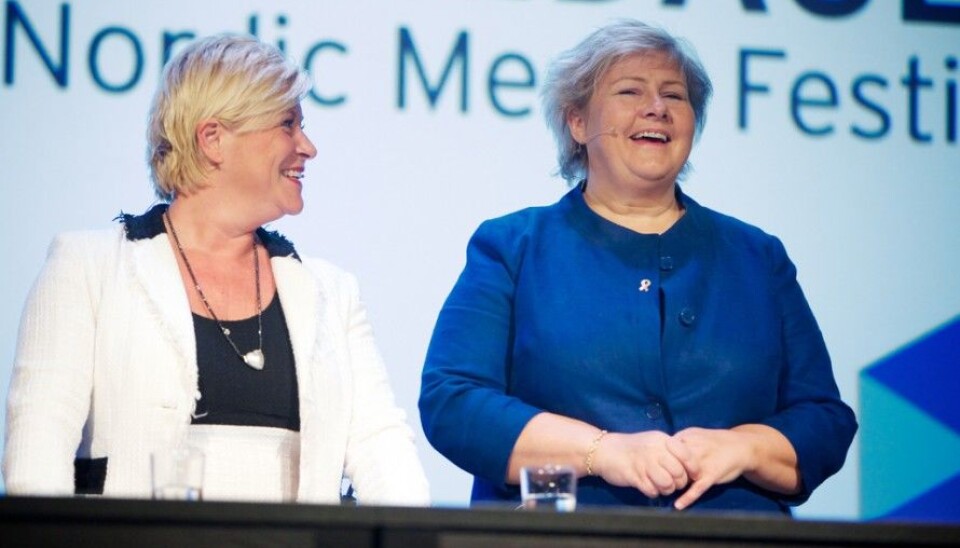An article from KILDEN Information and News About Gender Research in Norway

Media images of women are getting worse
The way women are represented in the media is getting worse every day, researchers say. However, the representation of Norwegian female politicians may be the exception to the general rule.
Denne artikkelen er over ti år gammel og kan inneholde utdatert informasjon.
"When I began my research on the representation of women and female politicians in the media in the eighties, people kept telling me that 'it will take time, but it will get better'. I believe that I have good reason to say that it hasn't. It has become worse," says Liesbet van Zoonen.
She is a Dutch professor of Communication and Media Studies, currantly working at Lougborough University in the UK. Among her numerous publications are her well-known books Feminist Media Studies from 1994 and Entertaining the Citizen: When Politics and Popular Culture Converge from 2005.
Shamelessly normal
She believes, however, that the two Norwegian politicians Erna Solberg and Siv Jensen are two exceptions.
"The representation of these women is exceptional seen within an international perspective. In general, few overweight women are seen in the media, and it is a relief to see women with a completely normal appearance who do not follow the prevailing beauty standards," van Zoonen says.

"It is unusual to see the female body so shamelessly displayed. In a video recording of Siv Jensen from the election night earlier this year, she is loud, she shouts to her audience; her behaviour is far from feminine. Her dress, on the other hand, compensates for her masculine behaviour. I presume she represents a very populist party? At least this is what her image implies," she says.
Norway's new political leaders seem to have extended the leeway for female politicians, but van Zoonen nevertheless points out that this type of female behaviour often evoke reactions from what she calls "the dark corners of the internet."
"It wouldn't surprise me if there have been deeply misogynous reactions towards both women on the internet. On a general basis, women in the public sphere are often exposed to such reactions, and especially so when they are so shamelessly normal and apparently proud of it as Solberg and Jensen," she says.
Media more extreme
To van Zoonen, Norway's Prime Minister and Minister for Finance are the exceptions that prove the rule.
"From a global perspective, it seems that things are getting worse, both in mainstream media and, particularly, on the internet. Newspapers such as the English Daily Mail have become more extreme lately. The media are constantly competing to gain people's attention and in order to make money they commercialise and popularise," says the professor.
Female politicians may appear almost invisible because they're not mentioned at all. On the other hand, they're in danger of being too much exposed due to their appearance, focus on emotions or on mistakes they've made. Moreover, when a female politician fails, she not only fails as a politician, the incompetence of her sex is revealed as well.
"The media culture has become more rough and populist. These tendencies are generally disadvantageous for women. Unless you're Siv Jensen, of course," she says.
Celebrity politics
Van Zoonen has carried out much research on popular culture and politics, and what she has labelled "celebrity politics". According to the professor, the encounter between female politicians and what she calls "the celebrity culture" is very often unfortunate.
"Politics is generally associated with masculinity, while celebrity culture is based on the super feminine. Female politicians end up somewhere in between. They are neither celebrities nor fully inside the political sphere," she says.
In her study of the British fashion magazine Grazia and their representation of young, female politicians during the 2010 election, van Zoonen has shown how female politicians attempted to be popular and appear beautiful in a sort of celebrity manner, and that this reduced the female politicians to become mere stereotypes.
The women from Labour Party were dressed in red and black, which could be associated with sex rather than serious politics. The women from The Conservative Party looked more like school girls. The politicians said in the interviews that they wished to be judged according to their politics, not their appearance.
"Nevertheless, by posing on these photographs they acknowledge the fact that it is important to look good," says van Zoonen.
According to the professor, the article which was supposed to challenge the stereotypes and evoke political interest did not succeed.
"This is the type of representation of women which is accessible in the celebrity culture. It rarely works for female politicians; it rather makes the situation worse," she says.
The fashion trick and motherhood
"However, the fact that the female politicians in Grazia failed in their attempt to present themselves through the celebrity culture does not mean that one shouldn't try," says van Zoonen.
Many politicians claim that they can make use of their sex to their own advantage. For instance, the Dutch politician Neelie Kroes became famous for the way she dressed. She used that as a strategy in order to get attention.
Another safe bet for a female politician's image is motherhood. However, the hildren must be grown up.
"If the children are small the female politician will be criticised for putting her career before her children and her family, and that the children suffer. If the children are grown up, on the other hand, the female politician may be regarded as mother to the whole nation. The Finnish president Tarja Halonen was called 'mother Finland' and Angela Merkel is called 'Mutti Merkel', mother Merkel," says van Zoonen.
Ditch the witch!
Quite a lot of research has been carried out concerning media's representation of female politicians, but most of the research is from the US, Western Europe and the Nordic countries.
"We definitely need similar research from a variety of other countries, although I doubt that the results will be much different," says van Zoonen.
"And it is important not to forget the misogyny," van Zoonen emphasises.
She mentions Australia and the campaign against the country's first female Prime Minister Julia Gillard as an example of obvious, public misogyny. Gillard was characterised as incompetent because she's a woman, the slogan against her being "ditch the witch".
"Although I haven't done any research on this particular case, I suspect that the way Julia Gillard was treated would have been impossible in the mid-nineties. This type of publicity has become much more common and more extreme as a result of the internet," claims van Zoonen.
Professional on the internet
But Gillard is also an example of how social media may work to the politician's advantage. A video showing her confrontation with opposition leader Tony Abbott and his sexist statements was rapidly broadcasted over the entire world and has been seen more than 2.5 million times.
"The good thing about social media is that it is possible to control how one is represented. There is no third person, or journalist, involved."
It is van Zoonen's opinion that there is far too little research on how politicians represent themselves in the social media. Her own analysis show that the majority represent themselves as professional politicians, but they give some information about their personal lives in order to appear as normal people with normal lives, not as distant technocrats.
Her analysis of how Angela Merkel and Hillary Clinton use the social media shows that these two women only focus on their political life.
Most high-standing politicians don't have much of a private life to focus on. But this may also reflect that women have to be careful in terms of what they choose to share.
Men also misrepresented
"Male politicians are also misrepresented as stereotypes in the media, and this tendency might even be growing," says van Zoonen.
"However, it is never as constraining for men as it is for women, who are generally only judged according to their appearance."
"Moreover, there are more male archetypes that the male politician can make use of in order to exercise leadership. They can be the hero, the sportsman, the business leader, the intellectual. For women, the only existing archetype for a female leader is the mother."
TV series guides the way
I see no reason why this would change, that it will get better simply because we draw attention to the phenomenon, says van Zoonen.
Yet she does sense a glimpse of hope.
"Fiction is the only place in which I find unproblematic representations of female politicians in the media. For instance Birgitte Nyborg in Borgen, MacKenzie Allen in Commander in Chief and Laura Roslin in Battlestar Galactica. And it was through popular culture that we got our first black president. Perhaps these TV series are showing us the future."

































